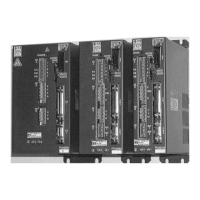
Do you have a question about the Sanyo SUPER BL P5 and is the answer not in the manual?
Provides an overview of safety precautions for the PY2 Servo Amplifier.
Identifies the location of warning labels on the Servo Amplifier.
Explains the meaning of warning symbols and ranks used in the manual.
Details general and wiring-specific safety cautions to prevent hazards.
Provides essential care instructions for unpacking the Servo Amplifier.
Outlines checks to perform after receiving the product to ensure it's correct and undamaged.
Lists important precautions to follow during the operation of the system.
Explains the methodology for decoding model numbers of servomotors and servo amplifiers.
Details the standard combinations of PY2 servo amplifiers and motors for proper system function.
Provides a flowchart to assist in determining the correct servomotor model number.
Describes the main built-in functions of the PY2 Servo Amplifier and special additions.
Details the key characteristics of the PY2 Servo Amplifier series, including volume and features.
Explains the characteristics of the servomotor series, including model range and compatibility.
Illustrates the external mounting and wiring connections for the servo system.
Identifies and describes the various parts and connectors on the servo amplifier.
Shows typical wire sizes for external terminals and connections for the Servo Amplifier.
Provides detailed external wiring diagrams for 200 VAC and 100 VAC input types.
Explains the terminal arrangements for CN1 (Interface Connector) and CN2 (Sensor Connector).
Lists crucial precautions to be observed during wiring to prevent noise and ensure safety.
Covers installation place and procedure for the servo amplifier.
Details precautions and methods for installing the servomotor indoors.
Provides guidance on handling cables to prevent stress or damage during installation.
Describes the sequence of operations for power ON, stopping, and servo OFF states.
Guides users through minimum wiring and initial functional checks before full operation.
Explains the procedure for clearing the encoder revolution counter or alarm using the remote operator.
Provides an overview and specifications of the optional remote operator.
Explains how to directly set various servo amplifier parameters using the keys.
Explains how to view and trace the alarm history stored in the amplifier.
Describes various test modes available for tuning and diagnostics.
Provides detailed explanations and tables for various parameters.
Summarizes key parameters, their standard values, units, and setting ranges.
Provides explanations for possible causes of alarms and corrective measures.
Lists causes and corrective measures for non-alarm malfunctions.
Lists parts that deteriorate with age and require periodic inspection or replacement.
Details the common specifications of the servo amplifier, including electrical and environmental data.
Provides common specifications for P3, P5, P6, and P8 series servomotors.
Contains detailed data sheets for various P series servomotor models.
Shows external views and dimensions of the servo amplifier, servomotor, and remote operator.
Explains built-in regenerative resistors, parameter settings, and external resistor selection.
Lists various warnings including overtravel, battery, and overload conditions.
Lists the international standards with which the PY2 Servo Amplifier complies.
Details CE marking requirements and conformity standards for EU market sales.
Covers UL and cUL marking qualifications and fuse recommendations.
Provides an overview of the servo amplifier's variety of servo and tuning functions.
Explains the function to switch control modes based on application requirements.
Describes the function to switch servo gain (Kp/Kvp/Tvi) during operation.
Details the function that estimates proper gain by motor operation and adjusts it in real-time.
Covers the function to automatically switch between velocity loop proportional and PI control based on motor speed.
Details the function for setting an external encoder for high-accuracy position control.